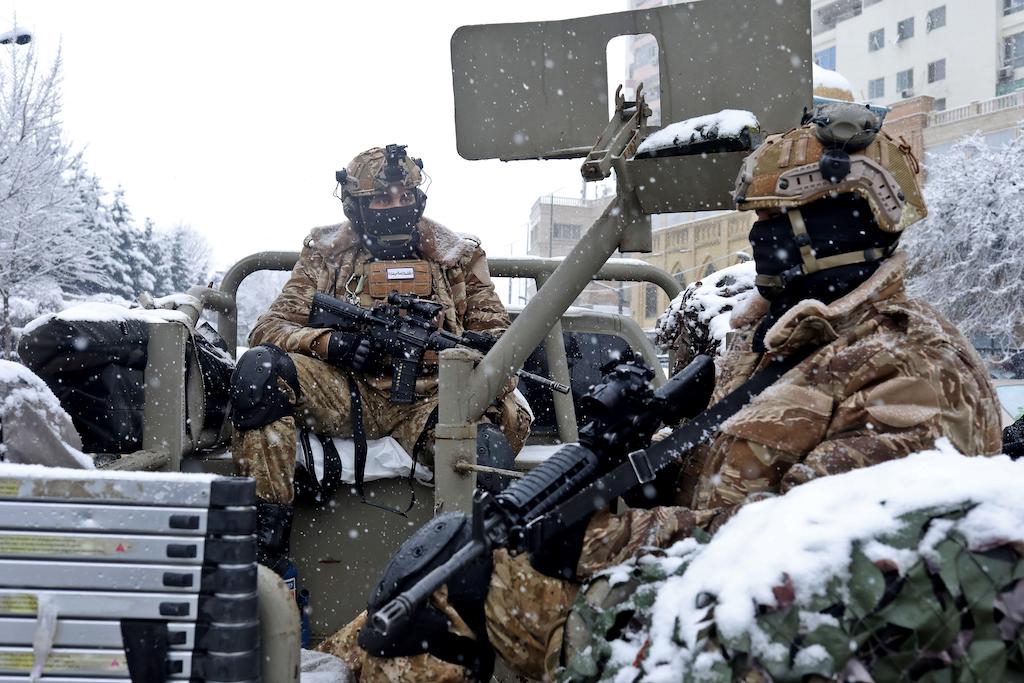After America’s retreat, the country’s media landscape has been trying to adjust to life under the Taliban. But every day makes life more impossible for journalists.

Khadija Amin, a TV anchor at a state-run channel was hopeful that the Taliban’s handling of media and free speech would’ve changed after the militant group swept to victory in Kabul. On her daily commute to the office, she recollects being unprepared for the events that drastically upended her four-year-long career in the media space, a rare milestone for a female journalist in Afghanistan.
The Taliban official asked why I came to office, Khadija said in a phone interview. As a first step, they stopped all women from working and asked them to go home. Some of them who are still working are publishing stories anonymously, she added. “We will allow women to work and study, women will be active in the society, but within the framework of Islam, spokesperson Zabihullah Mujahid said in the Taliban’s first press conference after U.S and NATO’s final withdrawal in August. For long, reporters speculated that ‘Zabihullah Mujahid’ was just a fabricated persona used by multiple Taliban spokespeople. When he made his first public appearance at a press conference, the Taliban dangled a new carrot: an end of an old regime of human rights violations. Since the political charade, what followed were mounting reports of Afghanistan journalists being detained, thrashed, and assaulted for generating content that defied the Taliban rule. The group has repeatedly shown that it will continue to shape domestic and international opinion in its favour. “We cannot trust them, what they promised in the press conference is far removed from reality”, Khadija added. She resettled to Spain and is currently a volunteer at a media outlet that publishes reports on social media. She takes Spanish language classes at a university in her locality. After being homebound for almost six years, Khadija said she realized the importance of learning the local language to resume working as a reporter. “I promised myself to never stop reporting or working as a journalist, it was my dream job, and It was not easy for me to pursue it. I want to help more women fight for their rights, Khadija said. She is one of the many reporters who have fled the country to resume reporting on Afghanistan from abroad.
A month after the U.S’s retreat from Kabul, Nematullah Naqabi, a reporter with Etilaat Roz, a local daily newspaper was covering a women-led protest in the West of Kabul. After Taliban gunmen circled the demonstration, they arrested Naqabi and his colleague despite their free-press pledge. He hoped his press card would protect him from the intimidation and assault that followed. “For about ten minutes they were beating us with sticks and after we passed out, they locked us in the cell”, Naqabi said. When he asked why he was being beaten, the Taliban replied that he was lucky he wasn’t beheaded, according to local media reports. After they were released without explanation, Etilaat Roz moved part of its staff out of the country. Naqabi boarded an evacuation flight to Qatar and currently lives in the United States.
Reporters who have chosen to stay in the country, continue their coverage under the apparition of self-censorship and fear. In November, Hamid Seighani, a former video editor with Ariana News was killed along with another civilian, in a bomb blast in Dasht-e-Barachi, Hazara district in Western Kabul. The Hazra Shia community, which is Afghanistan’s third-largest ethnic group, has a history of persecution under the hard-line Sunni rulers. The Taliban are also believed to have unlawfully carried out numerous cold-blooded execution attempts against the Hazaras during the reign. Ariana news merely reported that “a former employee was found dead in Kabul, without disclosing the circumstances surrounding his death. Media reports suggest there are unconfirmed sources that suggest that Saighani may not have died in the bus explosion, but instead was assassinated in Kabul.
According to a newly formed media watchdog, Nehad rasana-e- Afghanistan (NAI), around 257 media outlets shutdown with just three months since the Taliban takeover. Around 60 percent of media employees became jobless or left the country, the report added. Last month, reported that about 60 armed members and the General Directorate of Intelligence blocked a press conference by The Afghanistan Journalists Federation. Sayed Ali Asghar Akbarzadeh, a member of the collective told Committee to Protect Journalists (CPJ) in a phone interview that “one of the armed men” threatened retaliation if such events were held without Taliban permission. The Taliban are quickly proving that earlier promises to allow Afghanistan’s independent media to continue operating freely and safely are worthless, according to Steven Butler, Asia program coordinator for the CPJ. Butler’s U.S based press freedom organization which has been actively tracking violence against Afghan reporters said it had been receiving uncountable emails from journalists asking for help.
“We are scared, I’ll be honest with you, We are nervous,” Saad Mohseni, an Afgan-Australian entrepreneur told in an interview with CPJ. Mohseni founded Tolo, Afghanistan’s largest and most popular broadcaster, which is a part of a media conglomerate called Moby group that was established in 2002 with the help of the U.S government. Mohseni’s channel occasionally ran into trouble with President Hamid Karzai’s government. “We cut a lot of flesh, we pixelate things, we change storylines, but we still push the boundaries,” Mohseni said in an interview with New York Times. In 2015, a Tolo news journalist, Wali Arian reported that military officials in the northern Kunduz accused Taliban militants of having raped girls at a hostel. In response, the Taliban issued a grim warning that said reporters and offices of the channel would be considered “enemy personnel” and would be eliminated. One year later, a suicide bomber slammed his car into a bus carrying Tolo news employees, killing around seven staff members. The militant group accused the channel of “promoting foreign culture, nudity and obscenity”. Mohseni said he had prepared a contingency plan to broadcast Tolo from Europe or the Middle East if it is shut down.
Tolo news anchor Behesta Arghand made headlines for being the first Afghan female anchor to interview a senior Taliban spokesperson on the air, two days after the militant group’s takeover. Arghand was already on set in the studio when the official arrived. She recounts checking her clothes to ensure that all parts of her body were covered. The interview request was a propaganda coup to show that they would champion women’s rights. Days after the historic moment, her employer was asked to mandate hijabs for all the women working with her and eventually suspended all-female news anchors. Fearing for life and disheartened at the state of the press, the 24-year-old fled the country with the help of Malala Yousafzi, who got her into Qatar’s list of evacuees. Yousazai survived being shot by a former Pakistani Taliban spokesman in 2012 as a teenager, after which she was targeted for running what a senior Taliban member described as a “smearing campaign”
Afghanistan is ranked 122nd out of 180 countries in RSF’s 2021 World Press Freedom Index. Much of its independence and energy have been enabled with the help of the international community. A month after taking Kabul, Qari Muhammed Yousuf Ahmadi met several representatives of Afghan media outlets and rolled out a broadcasting guide containing 11 directives. Some of the rules include forbidding media outlets and journalists from generating content that conflicts with Islam principles or inciting ethnic prejudices. Reporters say some of the rules are vaguely worded and pave the way for dangerous censorship and persecution. Two months later, they issued eight further directives, prohibiting television opera shows and films from featuring women. “Taliban’s religious guidelines are tantamount to law and will be used to unduly persecute members of the media”, the International Federation of Journalists (IFJ) said in a statement.
When the Taliban regime was toppled in 2001, there was a proliferation of media outlets, including radio and television stations which received funding from the United States. For over two decades, these funds helped Afghans to mount their own platforms, hire journalists and generate content in the manner they desire. Since the takeover, the owners of privately-owned TV channels must navigate through the tough decision to stay on the air or to relocate. While Tolo TV continued broadcasting, several print media outlets have transitioned online, and some have halted operations to weather the economic turmoil. Job insecurity and unemployment have forced journalists to turn to working as street vendors among other professions.
Already forced to operate in one of the most dangerous and uncertain environments, Afghanistan’s media is also facing the problem of what Tolo’s Mohseni calls “a brain drain” His channel has helped many of the reporters to flee to countries like France, Europe and the U.S. “When they left, they left a huge vacuum. Now we have to hire like crazy, the brain drain will take us another two decades to build that sort of capacity”. He said in a media interview with CPJ. The mass exodus was also emboldened by the U.S state department’s refugee program which allowed citizens employed by U.S-based media organizations to resettle in the United States. As its last independent journalists are leaving the country and almost unnoticed by international audiences, Afghanistan’s tiny, remaining pockets of free opinion are dying a slow, painful death.
Rithika Krishna is a freelance writer and financial journalist based out of Bangalore, India.







